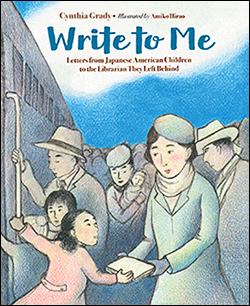“Poetry is really the fusion of three arts: music, storytelling, and painting.”
—Molly Peacock
For Teachers & Librarians

World War II and Japanese Americans: A Reading List [PDF]
Internment Camps:
–Amache, Colorado
–Gila, Arizona
–Heart Mountain, Wyom
–Jerome, Arkansas
–Manzanar, California
–Minidoka, Idaho
–Poston, Arizona
–Rohwer, Arkansas
–Topaz, Utah
–Tule Lake, California
Japanese American Incarceration during World War II
Dear Miss Breed: Letters from Camp. Japanese American National Museum.
Densho: The Japanese American Legacy Project
Preserves the testimonies of Japanese Americans imprisoned during World War II.
From Barbed Wire to Battlefields: Japanese American Experiences in WWII. National WWII Museum, New Orleans. Depicts the hardships suffered by Japanese Americans at home and honors those who fought during World War II.
Japanese American Citizens League. Founded in 1927, the oldest and largest Asian American Civil Rights organization in the US.
The War Relocation Centers of World War II: When Fear Was Stronger than Justice.
National Park Service. Provides “Teaching with Historic Places” lesson plans.
One-Two-One-Seven: A Story of Japanese Internment (video)
An award-winning video which tells a very poignant story of what happened to a once prosperous Japanese-American family in California.
Prisoners in Their Own Land: 75 years after Japanese internment (video)
A brief but very informative explanation which illustrates what happened to those in Washington State.
FDR’s Four Freedoms in a Divided America (audio)
Radio interview on WNYC’s The Takeaway, broadcast on FDR’s Four Freedoms.
From Internee To College Student: UConn’s Enrollment Of Japanese-Americans During WW II (audio)
One East Coast College that made a difference for a lucky few.
Of Civil Wrongs and Rights. The story of Fred Korematsu.
The Debate Over Japanese Internment Is Deeply Flawed
Essay by Constitutional Scholar Kermit Roosevelt in Time Magazine.
Japanese Internment and its Implications for Today
How censorship worked during WWII and beyond here in the United States, as seen through the story of photographer Dorothea Lange.
- The Art of Nonfiction Picture Books
- Charlesbridge Unplugged #1
- Classroom Connections: Like a Bird: The Art of the American Slave Song by Cynthia Grady
- Skinny Dip with Cynthia Grady
- Sharing Our Notebooks with Amy Ludwig VanderWater
- Cynthia Grady: Notebooks in My Sock Drawer
- Write Wild: Interview with Cynthia Grady
- Illustrator Michele Wood discusses I Lay My Stitches Down
Like a Bird: The Art of the American Slave Song

Had it not been for George L. White, treasurer and music professor at Fisk University in 1871, the world might have been deprived of the rich, haunting, intimate songs first sung by slaves—songs that we now call “spirituals.”
Learn more about Fisk University and the Fisk Jubilee Singers and their history. Listen to early recordings of these songs at the Library of Congress.
I Lay My Stitches Down: Poems of American Slavery

Poetry Practice: Quilt Block Poems [PDF]
The lesson plan above is designed to encourage metaphoric thinking. Give it a try!
The poems in I Lay My Stitches Down are written in the form of blank verse —unrhymed lines of iambic pentameter. But, they can also be read as dramatic monologues, similar to the monologues in Good Masters! Sweet Ladies! Voices from a Medieval Village by Laura Amy Schlitz.
Below is a guide to writing your own historical monologues:
Creating a Monologue [PDF]
For more on monologues, visit Washington, DC playwright,
Mary Hall Surface.
A Teacher’s Guide for I Lay My Stitches Down: Poems of American Slavery can be downloaded at Eerdmans Books for Young Readers
Some suggestions for implementing the Common Core State Standards with I Lay My Stitches Down. Common Core Connections [PDF]
